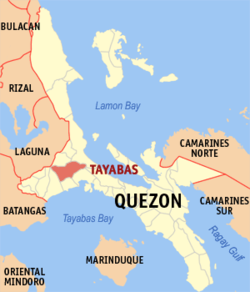
“The City of Festivals”
History
Even before the Spaniards came to the country, the natives of Tayabas was already organized into barangays headed by the village chiefs and councils of elders. It was when the Spaniards came that the place was properly organized into pueblo and church.
In more than three centuries of Spanish occupation, only eight cities and towns were given the title of Villa, and Tayabas was one of them. These are La Villa del Santisimo Nombre de Jesus de Cebu in 1565, La Villa de Santiago de Libon (Albay, 1573), La Villa Fernandina de Vigan (Ilocos, 1574), La Villa Rica de Arevalo (Iloilo, 1581), La Noble Villa de Pila (Laguna, 1610), La Muy Noble Villa de Tayabas, (Tayabas, 1703), La Villa de Bacolor (Pampanga, 1765), La Villa de Lipa (Batangas, 1887). Interestingly, that Tayabas was given the title of ‘most noble’ villa even before it became the provincial capital shows its importance even before 1779.
On March 18, 2007, Republic Act No. 9398, An Act Converting the Municipality of Tayabas in the Province of Quezon into a Component City to be known as City of Tayabas, was enacted into law. On July 14, 2007, the municipality held a plebiscite to ratify the conversion of the said act, with the residents voting in favor of the move, although there was a low turnout of voters for the plebiscite.
But years after that, the cityhood of Tayabas and of other 15 cities were lost after the Supreme Court decided to get it from them because it didn’t reach the qualifications for cityhood.
But on August 24, 2010, in a 16-page resolution, the Supreme Court reinstated its November 18, 2008 decision striking down the Cityhood lawsmaking Tayabas a municipality again.
The most recent development in the legal battle surrounding the “League of 16” came on February 15, 2011. Voting 7-6, the Supreme Court ruled that the 16 towns can stay as cities. It is the fourth time that the Supreme Court ruled on the case, and the third reversal, something that is unprecedented in its history. It said the conversion of the 16 towns into cities met all legal requirements.
Population/ Language/ Area
As of 2010, Tayabas City recorded a total population of 91,428.
Located at the southeastern foothills of Mount Banahaw, Tayabas is bounded on the north by the town of Lucban, on the east by Atimonan, on the south by Lucena City and Pagbilao, and on the west by Sariaya. The city occupies a total land area of 230.95 km2 (89.17 sq mi).
The city has a total land area of 301 square kilometers, most of which are rural areas devoted to agriculture.
Products and Services
Tayabas is known for its weaving industry. Other cottage industries include production of lambanog wine, macapuno candy, furniture and automotive shops.
Agricultural products include rice, coconut, root crops, and vegetables.
Business Opportunity
The city is a potential spot for small and medium enterprises which include coconut processing like virgin coconut oil and oleochemicals, essential oil and fragrances, furniture and fixture, hotels and resorts, cacao and coffee production and processing and demonstration farms.
Tourist Spots
- Nawawalang Paraiso Hotel and Resort – this is a perfect paradise for travelers and vacationists. From the resort is the view of the Mt. Banahaw.
- Mainit Hot Spring – is a natural converted into wadding pools, bathtubs, and swimming pool for therapy and relaxation.
Festivals and Celebrations
- Mayohan sa Tayabas – a stellar attraction during month of May where a grand, colorful and folsky Parada ang Baliskog welcomes a guest to Mayohan Festival. “kog” means arc, a welcome arc. A display of baliskog made indigenous materials like coco leaf, coco husk, bamboo poles, buli, rattan, dried flowers and tistis fiiled the streets of Tayabas and joyously welcome visitors and the summer season.Mayohan Festival ranks as major festival in the region. It continually draws large number of crowd since it started in 1989.
- Hagisan ng Suman Festival – “Suman” is the ritual gift of Hagisan wherein the natives have the opportunity to share their prosperity. As soon as the image of San Isidro passes by, the bagakay must be emptied of its colourful array of abundance, which aside from suman, includes banana, mango, buko, pineapple and other local farm produce. In most houses, suman and other farm produce are no longer tied in bagakay, they simply throw them with passion and great enthusiasm from their decks, balconies, or windows to the multitudes of peasants and workers. Hagisan means throwing or sharing away.
- Taytsinoy Festival – as part of Chinese New Year, Tayabas City celebrates this festival as the city’s way of building a national relationship to Chinese society. Aligned with this were some Chinese activities being adopted by Tayabenses and contests like Chinese Garter Contest, Kiamoy Eating Contest, Chopstikan ng Pancit Habhab, Binibining Taytsinoy, and a lot more. The highlight of the event was the Dragon and Chinese Presentation in Parke Rizal and Pagdalaw ng Leon at ng Dragon at Tayabas Poblacion wherein all people undeniably enjoyed, especially the children.The four days celebration embodying numerous events greatly gave bunch of fun to all Tayabenses and guests. Ultimate learning, awareness of the Chinese culture and tradition, and endless merriment were being brought out by the municipality.
